August is a month of transition in the garden. Nights start to grow shorter but days are hot and dry. Early summer blooms begin to fade while buds for autumn blooms are now appearing and will break soon. Pests and diseases in the garden often peak this month.
Roses and perennials need deadheading in August. Some annuals are spent and need to be removed, while others will thrive in the heat. Seeds of fall and winter annuals should be planted now. Seeds for spring and summer blooming perennials–next year’s crop–should be sown this month.
Weeds need immediate attention; an old farmers’ adage says one year of dropped weed seed means seven years of weeds. Don’t let weeds flower! Water and mulch in August. Slow deep watering will sustain plants and mulch will stem soil moisture evaporation.
Now is the time to look ahead to the first frost and mark it on your calendar. It may come in September in northern regions and can be a few months off in southern regions, but it’s important to know when.
If you are unsure when the last frost in spring happens where you live–and when the first frost in autumn comes. Go to this post: Average Last and First Frost Dates for Cities, States, and Countries. The months between the last frost in spring and the first frost in autumn is the natural growing season for your region.
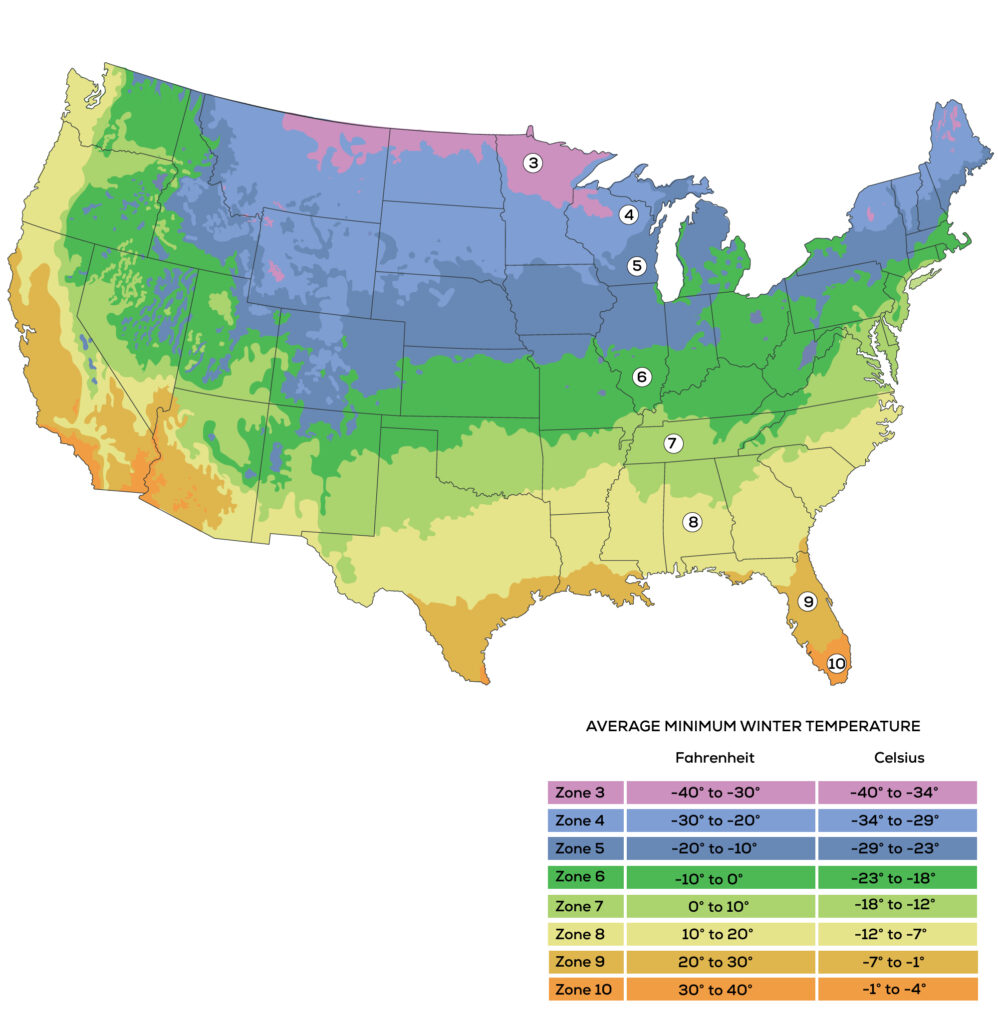
Zones 8 to 11 have 6 to 8 weeks or more of prime garden time to come. Zones 3 to 7 have four to 8 weeks of growing time left this year. Here are our tips for August. Find your zone on the map above and see our tips below.
Tips for Zones 8-11:
General Tasks: Water all plants regularly, giving priority to relatively new plants and those that are particularly intolerant of drought. In dry areas keep watering and keep plants, beds, and borders, mulched to conserve moisture, keep roots cool, and control weeds.
Trees: Remove trees that are weak or rotted. Prune water sprouts and suckers from young trees. Transplant evergreens. Plant container trees. Plant palm trees. Aerate compacted soil around roots. Water as necessary. Make sure new plantings get plenty of water; water established plants as needed. Weed soil around trees; apply preemergent herbicide. Check for insects and diseases. Take softwood cuttings. Order stock for fall planting.
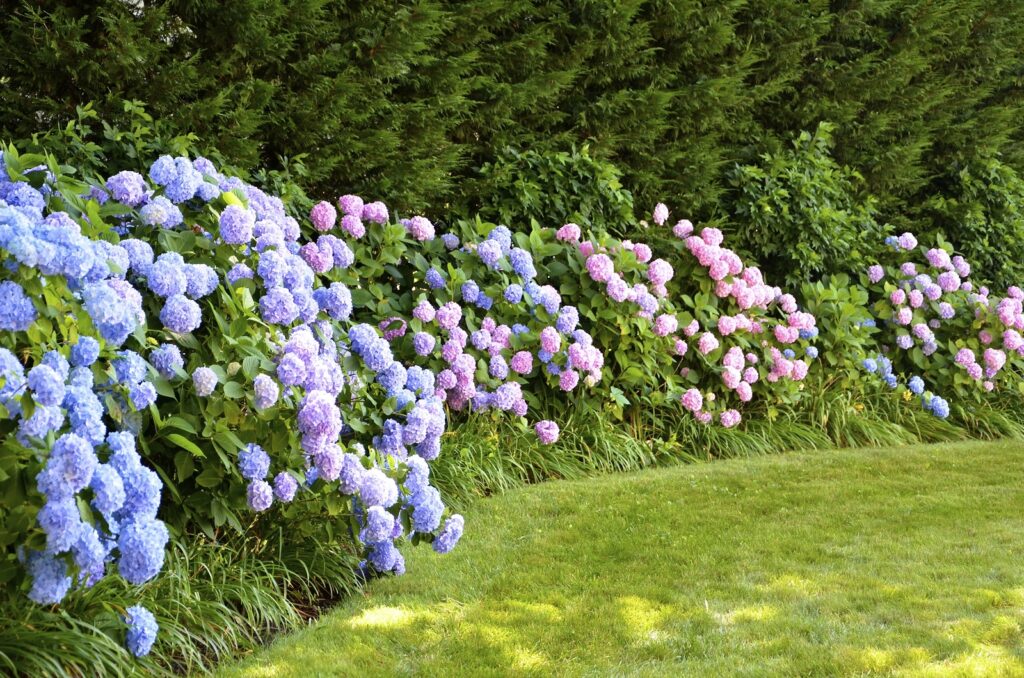
Shrubs: Prune shrubs after flowering. Trim hedges, topiaries, and espaliers. Shear formal hedges. Clip beech, holly, hornbeam, and yew hedges, and most evergreen hedges, if not already done so. Shear fine-needled evergreens. Prune shrubs, such as ceanothus, escallonias, and lavender that have finished flowering, shortening stems, and thinning out old wood. Prune wisteria by pinching out young shoots beyond three or four leaves. Train and prune vines. Continue to tie in new shoots on climbing plants and pinch out growing tips. Take semi-ripe cuttings of deciduous and evergreen shrubs and root them in a cold frame. Insert cuttings of garryas and wisterias in cuttings compost and place in a propagating unit with bottom heat. Layer rhododendrons – they make take three or four years to root. Take tip cuttings of heathers. Take cuttings of hydrangeas, rooting them in small pots of gritty compost in a cold frame. Plant potted shrubs and vines. Make sure new plantings get plenty of water; water established plants as needed. Azaleas, camellias, and fuchsias need constant moisture. Feed azaleas, camellias with liquid plant food. Water consistently in all dry areas or dry spells. Fertilize spring bloomers now setting buds. Weed soil around shrubs. Replace mulch as needed. Check for insects, diseases. Order stock for fall planting. Watch for pests and signs of disease. Take softwood cuttings.
Roses: Remove faded flowers. Disbud roses and other flowering plants for larger blooms. Remove side buds to encourage large single blossoms or remove terminal buds to encourage clusters of blossoms. Prune rambler roses once flowering is over. To prevent the development of soft growth in autumn, stop applying rose fertilizer. Spray roses against a fungal attack such as powdery mildew, rust, and blackspot. In hot dry spells watch for mildew on ramblers and roses growing on walls, in dry soil, or in sunny, sheltered positions. Pick up dropped leaves. Remove and discard diseased leaves. Plant container-grown roses. Water as needed. Lay fresh mulch, or keep roses weeded. Fertilize roses with granular fertilizer or apply liquid fertilizer. Watch for pests and signs of disease. Propagate by budding. Take softwood cuttings of shrub roses to start new plants. Order roses for fall planting.

Lawns and Ground Covers: Mow and edge the lawn as needed. Lay sod for warm-season lawns. Last call to sow Bermuda grass now. Consider carefully the type of seed you choose to create your new lawn. A variety of different blends are available for fine or rough lawns, sun, or shade. Making a new lawn from turf gives an instant finish but is more expensive than seed. Turf too is available in different grades for different purposes but may need to be ordered. Apply a lawn fertilizer with relatively high phosphate and potassium levels to encourage the development of strong roots. A week after feeding, sow lawn seed, ensuring that it is sown evenly and protected from birds by netting or cotton twine. Water lawns as needed in dry weather. Water the lawn in dry spells, but a few good soaks will be better than many sprinklings that do not penetrate deeply. Always water well after applying any kind of fertilizer. Check for insects, diseases. Apply weed killer and spray for disease and pests. Prune ground covers if needed; trim low-growing plants. Collect seeds from selected ornamental grasses and ground covers. Cut stalks of annual ornamental grasses for indoor display. Plant ground covers, perennial ornamental grasses. Water as needed. Fertilize newly planted ground covers and ornamental grasses. Order ornamental grasses for fall planting.
Perennials: Harvest cut flowers for indoor displays. Cut flowers for drying. Deadhead faded flowers. Cut back early bloomers when foliage begins to die back. Cut back or remove rampant perennials in borders that threaten to crowd out more desirable species. Remove spent blooms. Continue to cut back rampant vines that encroach on trees, shrubs, or other plants. Pinch chrysanthemums to encourage new blossoms. Divide crowded spring bloomers. Divide and replant iris. Check for borers and root rot. Shear ground covers and rock-garden plants. Stake as needed all tall-growing plants still in bloom or about to flower. Refrigerate cool-weather perennial seeds like delphinium, pansy, and viola before sowing (far South). Water if the ground is dry. Weed. Check summer mulch. Lay fresh mulch where needed. Fertilize perennials as necessary. Feed fuchsias; chrysanthemums with liquid plant foods. Watch for pests and signs of disease. Check for mildew in hot, wet climates. Sprays and dust should be applied at regular intervals. This is the peak time for pests and diseases; watch chrysanthemums and dahlias for aphids, red spiders; dahlias for stem borers (slit stems and remove borers); watch for mildew on annuals, perennials, and lilacs. Take cuttings to start new plants. Take fuchsias and pelargonium cuttings. Order stock for fall planting. Prepare soil for fall planting.

Bulbs: Deadhead faded flowers. Stake tall gladiolus and dahlias. Prune side branches of dahlias to produce large flowers. Divide and transplant daylilies, cilia, Oriental poppies, and peonies. Dig up irises; check for borers and root rot. Divide and replant iris. Plant autumn-flowering bulbs. Plant bulbs for a late bloom: nerine, lycoris. Plant calla lily, clivia, and ranunculus. Plant Amaryllis, autumn crocus, Fritillaria, Lilium, and Sternbergia bulbs. Plant colchicums, to flower in the autumn. Plant Easter lily bulbs –varieties Croft or Creole – as soon as delivered; also Madonna lilies, Louisiana and Japanese iris, fall- and winter-flowering bulbs. Water bulbs during dry weather. Fertilize summer-flowering bulbs. Watch for pests and signs of disease. Order hardy bulbs for fall planting; store in the refrigerator until planting time. Order spring-flowering bulbs.
Annuals: Cut flowers for indoor displays. Cut flowers for drying. Deadhead faded flowers or shear back plants to promote reblooming. Collect seeds from selected flower heads. Shear back plants whose blooms are slowing to promote re-blooming, or remove and replace with new plants. Remove and replace worn-out plants. Renew fading flowerbeds by filling them with fast-growing marigolds, zinnias, and annual vinca. Pinch back tall-growing plants. Train vines and climbing annuals. Stake tall-growing plants. Sow pansies and hardy annual seeds indoors or outdoors. Sow biennial seeds indoors or outdoors. Direct-sow foxglove, larkspur, cosmos, and hollyhocks. Sow calendula, myosotis, stock, viola, and wallflower. Thin biennial seedlings. Water as needed. Fertilize plants. Weed flower beds. Lay fresh mulch on beds and borders. Watch for pests and signs of disease. Combat pests and fungal disease using organic means, applying insecticides and fungicides only if necessary. Prepare soil for fall planting.
Container Gardens: Deadhead faded flowers. Cut flowers from containers. Pinch back trailing plants, such as ivy-leaved pelargoniums, that are becoming straggly. Prune to shape shrubs that have finished flowering. Remove worn-out plants and replace them with new ones. Train climbers; trim and train topiaries. Water as needed. Weed and fertilize plants regularly. Watch for pests and signs of disease. Provide stock for next year by taking cuttings of fuchsias, pelargoniums, and other good container plants that cannot be raised from seeds.

Tips for Zones 3-7:
General Tasks: Water all plants regularly, giving priority to relatively new plants and those that are particularly intolerant of drought. Give deep, slow waterings and measure the depth to which it permeates. It should reach 6 to 8 inches (15-20cm). Fertilize plants, if needed, for the last time until dormancy. Keep the garden free of weeds. Water as needed. Spray with insecticides and fungicides if needed. Summer mulches help to hold moisture, protect plants from the heat by keeping roots cool and help to keep down weeds.
Trees: Remove trees that are weak or rotted. Transplant evergreens. Plant container and balled-and-burlapped trees. Plant container-grown evergreens if the weather is not too stressful. Make sure new plants get water in hot, dry weather; water established plants during extended dry spells. Aerate compacted soil around roots. Weed soil around trees; apply preemergent herbicide. Take softwood cuttings. Watch for pests and signs of disease. Order stock for fall planting.
Shrubs: Prune summer-blooming vines and shrubs after they finish flowering. Trim hedges, topiaries, and espaliers. Shear formal hedges. Shear fine-needled evergreens. Clip beech, holly, hornbeam, and yew hedges, and most evergreen hedges, if not already done so. Train and prune vines. Plant container-grown and bare-root shrubs and evergreens if the weather is not too stressful. Water established plants during extended dry spells. Make sure new plants get water in hot, dry weather. Reduce water on broad-leaved evergreens in the above class. Weed soil around shrubs. Replace mulch as needed. In regions where early frosts occur, withhold plant food and water after August 15 from roses, azaleas, rhododendrons, and other woody plants, soft growth of which may be injured by an early frost. Watch for pests and signs of disease. Order stock for fall planting. Take softwood cuttings. Take semi-ripe cuttings.
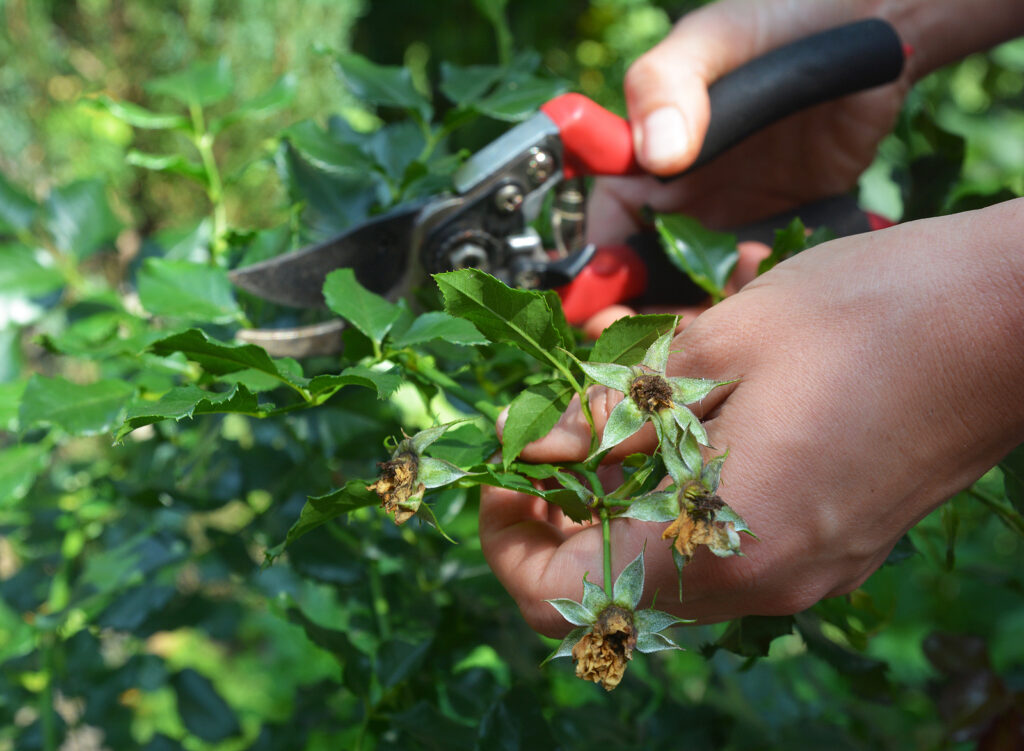
Roses: Deadhead faded flowers. Remove side buds to encourage large single blossoms, or remove terminal buds to encourage clusters of blossoms. Pick up dropped leaves. Prune rambler roses once flowering is over. Where short-growing season and low winter temperatures keep roses and other plants from attaining tall, heavy growth, cut flowers with short stems to conserve stem growth and foliage. Plant container-grown roses. Water if the weather is dry. Continue mulching. Fertilize for the last time six weeks before you expect the first fall frost. Apply granular fertilizer until mid-August. Apply supplemental liquid fertilizer until mid-August. Take softwood cuttings of shrub roses to start new plants. Order roses for fall planting. Watch for pests and signs of disease. Spray roses against a fungal attack such as powdery mildew, rust, and blackspot. Remove and discard diseased leaves. Propagate by budding. Take softwood cuttings of shrub roses to start new plants.
Lawns and Ground Covers: Mow the lawn weekly except in very dry weather. Lawn areas for fall seeding should be prepared early this month. Seeding can be undertaken late in August or in early September. Water the lawn in dry spells, but a few good soaks will be better than many sprinklings that do not penetrate deeply. Continue to water regularly and thoroughly during hot, dry weather. Apply a lawn fertilizer with relatively high phosphate and potassium levels to encourage the development of strong roots. Always water well after applying any kind of fertilizer. Trim back herbaceous plants that have grown excessively and flopped over the lawn edges. Cut stalks of annual ornamental grasses for indoor display. Collect seeds from selected ornamental grasses and ground covers. Prune ground covers if needed; trim low-growing plants. Plant ground covers, perennial ornamental grasses. Water as needed. Weed ground cover areas if necessary. Fertilize newly planted ground covers and ornamental grasses. Check for insects, diseases. Order ornamental grasses for fall planting.
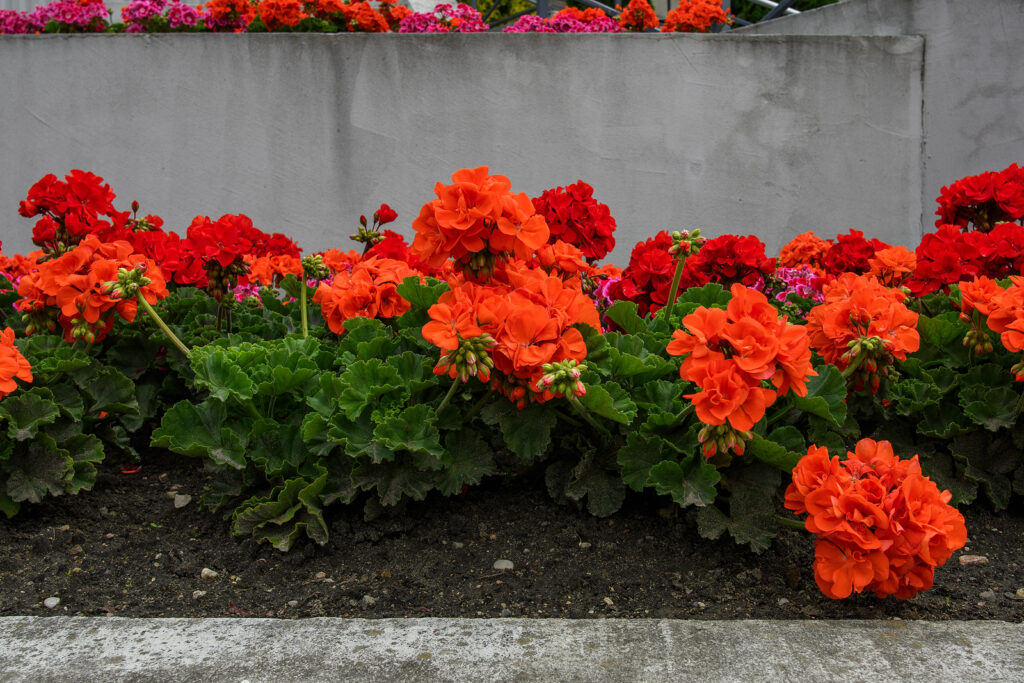
Perennials: Harvest cut flowers for indoor displays. Remove spent blooms. Cut back early bloomers when foliage begins to die back. Cut off phlox blooms before seeds drop. Pinch stem tips off chrysanthemums. Stake tall-growing plants before heavy blooms bend them over. Divide crowded spring bloomers. Sow perennials and biennials for bloom next year. Plant chrysanthemums in bud and bloom. Plant poppies and peonies. Water if the ground is dry. Fertilize plants, if needed, for the last time until dormancy. Feed chrysanthemums, hardy asters for the last time. Weed beds and borders regularly. Check summer mulch. Watch for pests and signs of disease. Take cuttings to start new plants. Take fuchsias and pelargonium cuttings. Order stock for fall planting. Prepare soil for fall planting.
Bulbs: Deadhead faded flowers. Feed and disbud dahlias as necessary. Prune side branches of dahlias to produce large flowers. Dig up irises; check for borers and root rot. Divide and replant iris. Cut lilies back to the ground when stalks die back. Stake tall glads and dahlias. Plant fall-flowering bulbs. Plant Amaryllis, autumn crocus, Colchicum, Fritillaria, Lilium, and Sternbergia bulbs for fall bloom. Water during dry weather. Fertilize summer-flowering bulbs. Watch for pests and signs of disease. Order spring-flowering bulbs. Start planting spring-flowering bulbs.
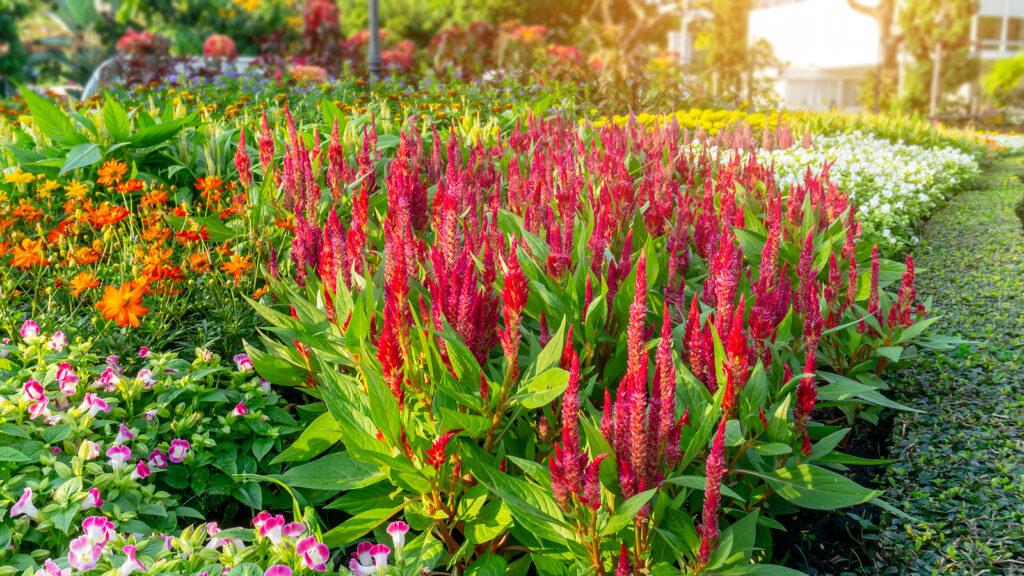
Annuals: Cut flowers for indoor displays. Cut flowers for drying. Collect seeds from selected flower heads. Keep dead blooms cut off to prevent seeding. Pinch back tall-growing plants. Shear back plants whose blooms are slowing to promote re-blooming or remove and replace with new plants. Stake tall-growing plants. Train vines and climbing annuals. Sow hardy and half-hardy annual seeds indoors or outdoors. Sow biennial seeds indoors or outdoors. Thin biennial seedlings. Start sowing hardy annuals to over-winter (only in mild areas or if you can provide winter protection). Water as necessary. Weed flower beds. Give copious water, fertilize lightly between bursts of bloom, and mulch to conserve moisture and protect from heat. Watch for pests and signs of disease. Combat pests and fungal disease using organic means, applying insecticides and fungicides only if necessary. Remove mildewed plants.
Container Gardens: Deadhead faded flowers. Train climbers; trim and train topiaries. Water as needed. Feed plants in containers to keep the blooms coming. Watch for pests and signs of disease.
Greenhouse: Take cuttings of ivy-leaved and zonal pelargoniums and pot them up. Take semi-ripe cuttings of Berberis, Camellia, Ceanothus, Cotoneaster, Daphne, and Mahonia. Sow spring-flowering plants such as cyclamen. Schizanthus and exacums. Continue to feed pot plans regularly. Take leaf and semi-ripe cuttings. Keep a vigilant watch for pests and diseases. Pot on and pot up seedlings and young plants as necessary. Plant hyacinths for early flowering under glass; check cinerarias for life miners (white ‘tunnels’ in leaves). Remove affected leaves or control with a systemic insecticide.



